Economic Policies and Global Environment: A Comprehensive Overview
VerifiedAdded on 2021/06/18
|10
|2222
|41
Essay
AI Summary
This essay delves into the intricate relationship between economic policies and the global environment, focusing on macroeconomic strategies employed by governments to foster long-term growth and maintain short-term stability. It begins by outlining the evolution of the global economic framework, emphasizing the influence of globalization, liberalization, and technological advancements. The essay then explores the two primary types of macroeconomic policies: fiscal policies, which involve government spending and taxation, and monetary policies, managed by monetary authorities to control money supply and interest rates. It examines specific policies aimed at increasing productivity, such as capital formation, labor productivity enhancement, and technological innovation. Furthermore, the essay discusses policies designed to reduce unemployment and manage inflation through targeted interest rates. Real-world examples, such as Australia's capital formation and inflation targeting, illustrate the practical application of these policies. Finally, the essay highlights the importance of maintaining short-run economic stability through monetary policies like adjusting interest rates to counter inflationary pressures or stimulate demand. The essay concludes by emphasizing the significance of both fiscal and monetary policies in promoting economic welfare and ensuring the overall health of the global economy.
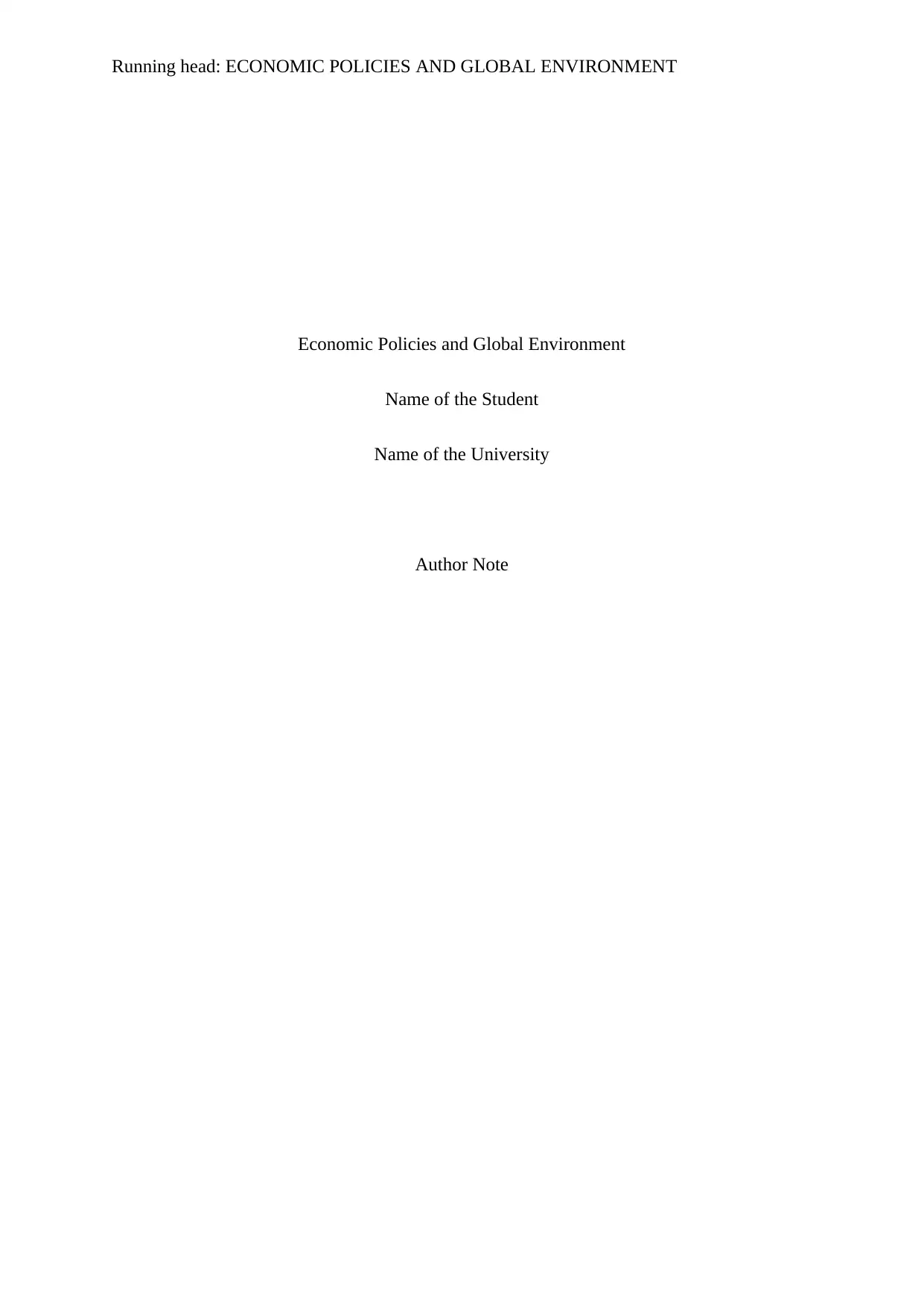
Running head: ECONOMIC POLICIES AND GLOBAL ENVIRONMENT
Economic Policies and Global Environment
Name of the Student
Name of the University
Author Note
Economic Policies and Global Environment
Name of the Student
Name of the University
Author Note
Paraphrase This Document
Need a fresh take? Get an instant paraphrase of this document with our AI Paraphraser
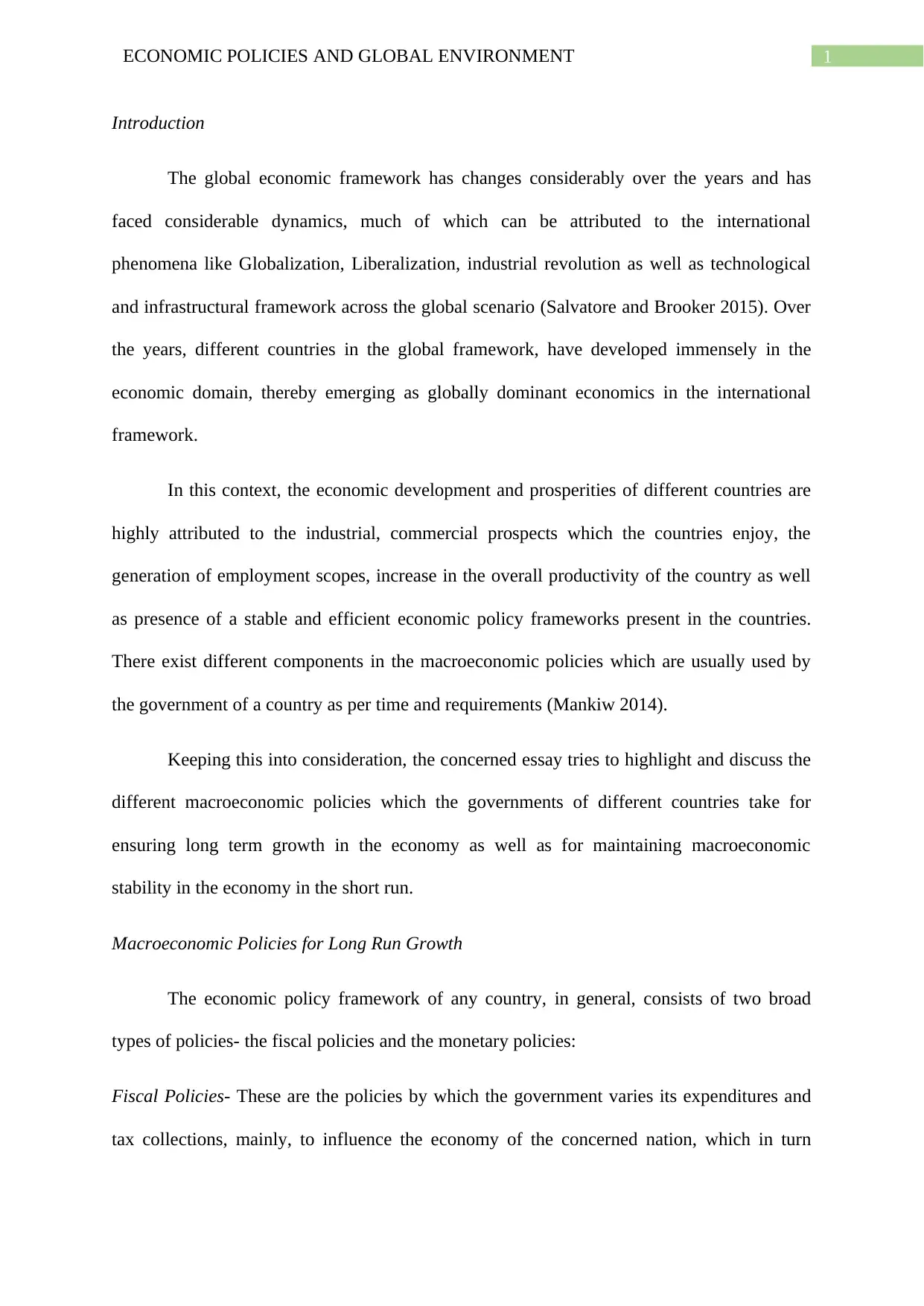
1ECONOMIC POLICIES AND GLOBAL ENVIRONMENT
Introduction
The global economic framework has changes considerably over the years and has
faced considerable dynamics, much of which can be attributed to the international
phenomena like Globalization, Liberalization, industrial revolution as well as technological
and infrastructural framework across the global scenario (Salvatore and Brooker 2015). Over
the years, different countries in the global framework, have developed immensely in the
economic domain, thereby emerging as globally dominant economics in the international
framework.
In this context, the economic development and prosperities of different countries are
highly attributed to the industrial, commercial prospects which the countries enjoy, the
generation of employment scopes, increase in the overall productivity of the country as well
as presence of a stable and efficient economic policy frameworks present in the countries.
There exist different components in the macroeconomic policies which are usually used by
the government of a country as per time and requirements (Mankiw 2014).
Keeping this into consideration, the concerned essay tries to highlight and discuss the
different macroeconomic policies which the governments of different countries take for
ensuring long term growth in the economy as well as for maintaining macroeconomic
stability in the economy in the short run.
Macroeconomic Policies for Long Run Growth
The economic policy framework of any country, in general, consists of two broad
types of policies- the fiscal policies and the monetary policies:
Fiscal Policies- These are the policies by which the government varies its expenditures and
tax collections, mainly, to influence the economy of the concerned nation, which in turn
Introduction
The global economic framework has changes considerably over the years and has
faced considerable dynamics, much of which can be attributed to the international
phenomena like Globalization, Liberalization, industrial revolution as well as technological
and infrastructural framework across the global scenario (Salvatore and Brooker 2015). Over
the years, different countries in the global framework, have developed immensely in the
economic domain, thereby emerging as globally dominant economics in the international
framework.
In this context, the economic development and prosperities of different countries are
highly attributed to the industrial, commercial prospects which the countries enjoy, the
generation of employment scopes, increase in the overall productivity of the country as well
as presence of a stable and efficient economic policy frameworks present in the countries.
There exist different components in the macroeconomic policies which are usually used by
the government of a country as per time and requirements (Mankiw 2014).
Keeping this into consideration, the concerned essay tries to highlight and discuss the
different macroeconomic policies which the governments of different countries take for
ensuring long term growth in the economy as well as for maintaining macroeconomic
stability in the economy in the short run.
Macroeconomic Policies for Long Run Growth
The economic policy framework of any country, in general, consists of two broad
types of policies- the fiscal policies and the monetary policies:
Fiscal Policies- These are the policies by which the government varies its expenditures and
tax collections, mainly, to influence the economy of the concerned nation, which in turn
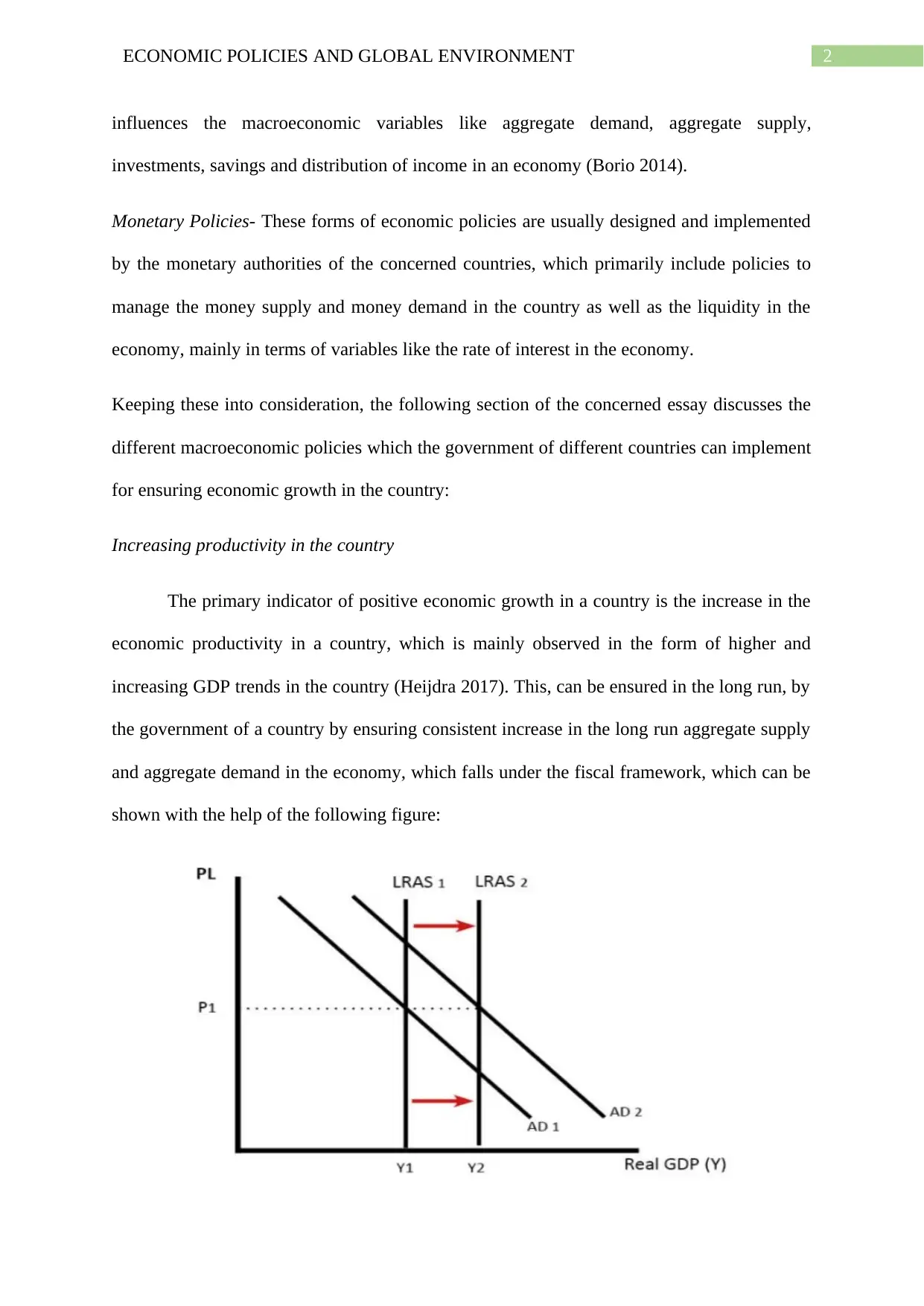
2ECONOMIC POLICIES AND GLOBAL ENVIRONMENT
influences the macroeconomic variables like aggregate demand, aggregate supply,
investments, savings and distribution of income in an economy (Borio 2014).
Monetary Policies- These forms of economic policies are usually designed and implemented
by the monetary authorities of the concerned countries, which primarily include policies to
manage the money supply and money demand in the country as well as the liquidity in the
economy, mainly in terms of variables like the rate of interest in the economy.
Keeping these into consideration, the following section of the concerned essay discusses the
different macroeconomic policies which the government of different countries can implement
for ensuring economic growth in the country:
Increasing productivity in the country
The primary indicator of positive economic growth in a country is the increase in the
economic productivity in a country, which is mainly observed in the form of higher and
increasing GDP trends in the country (Heijdra 2017). This, can be ensured in the long run, by
the government of a country by ensuring consistent increase in the long run aggregate supply
and aggregate demand in the economy, which falls under the fiscal framework, which can be
shown with the help of the following figure:
influences the macroeconomic variables like aggregate demand, aggregate supply,
investments, savings and distribution of income in an economy (Borio 2014).
Monetary Policies- These forms of economic policies are usually designed and implemented
by the monetary authorities of the concerned countries, which primarily include policies to
manage the money supply and money demand in the country as well as the liquidity in the
economy, mainly in terms of variables like the rate of interest in the economy.
Keeping these into consideration, the following section of the concerned essay discusses the
different macroeconomic policies which the government of different countries can implement
for ensuring economic growth in the country:
Increasing productivity in the country
The primary indicator of positive economic growth in a country is the increase in the
economic productivity in a country, which is mainly observed in the form of higher and
increasing GDP trends in the country (Heijdra 2017). This, can be ensured in the long run, by
the government of a country by ensuring consistent increase in the long run aggregate supply
and aggregate demand in the economy, which falls under the fiscal framework, which can be
shown with the help of the following figure:
⊘ This is a preview!⊘
Do you want full access?
Subscribe today to unlock all pages.

Trusted by 1+ million students worldwide
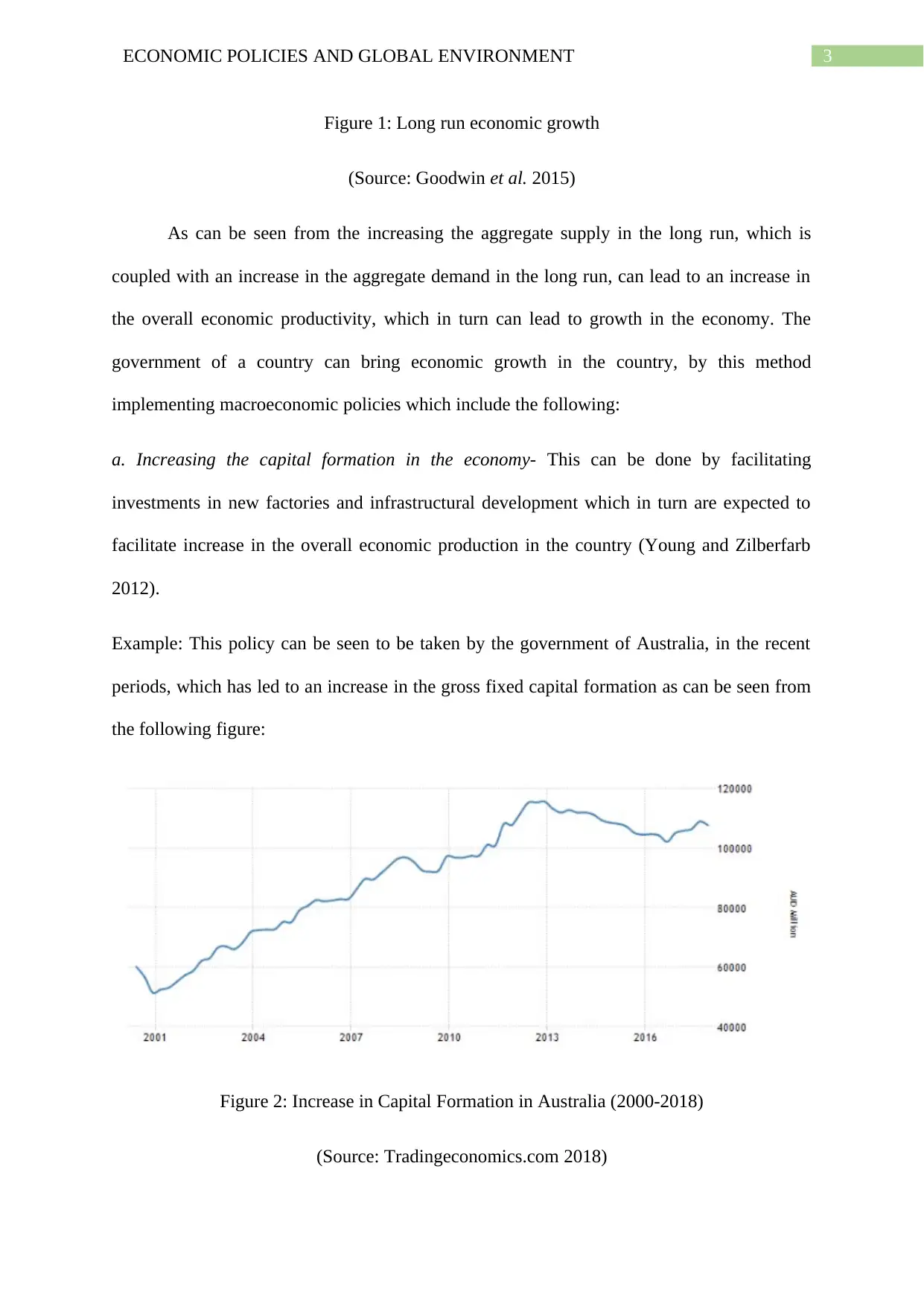
3ECONOMIC POLICIES AND GLOBAL ENVIRONMENT
Figure 1: Long run economic growth
(Source: Goodwin et al. 2015)
As can be seen from the increasing the aggregate supply in the long run, which is
coupled with an increase in the aggregate demand in the long run, can lead to an increase in
the overall economic productivity, which in turn can lead to growth in the economy. The
government of a country can bring economic growth in the country, by this method
implementing macroeconomic policies which include the following:
a. Increasing the capital formation in the economy- This can be done by facilitating
investments in new factories and infrastructural development which in turn are expected to
facilitate increase in the overall economic production in the country (Young and Zilberfarb
2012).
Example: This policy can be seen to be taken by the government of Australia, in the recent
periods, which has led to an increase in the gross fixed capital formation as can be seen from
the following figure:
Figure 2: Increase in Capital Formation in Australia (2000-2018)
(Source: Tradingeconomics.com 2018)
Figure 1: Long run economic growth
(Source: Goodwin et al. 2015)
As can be seen from the increasing the aggregate supply in the long run, which is
coupled with an increase in the aggregate demand in the long run, can lead to an increase in
the overall economic productivity, which in turn can lead to growth in the economy. The
government of a country can bring economic growth in the country, by this method
implementing macroeconomic policies which include the following:
a. Increasing the capital formation in the economy- This can be done by facilitating
investments in new factories and infrastructural development which in turn are expected to
facilitate increase in the overall economic production in the country (Young and Zilberfarb
2012).
Example: This policy can be seen to be taken by the government of Australia, in the recent
periods, which has led to an increase in the gross fixed capital formation as can be seen from
the following figure:
Figure 2: Increase in Capital Formation in Australia (2000-2018)
(Source: Tradingeconomics.com 2018)
Paraphrase This Document
Need a fresh take? Get an instant paraphrase of this document with our AI Paraphraser
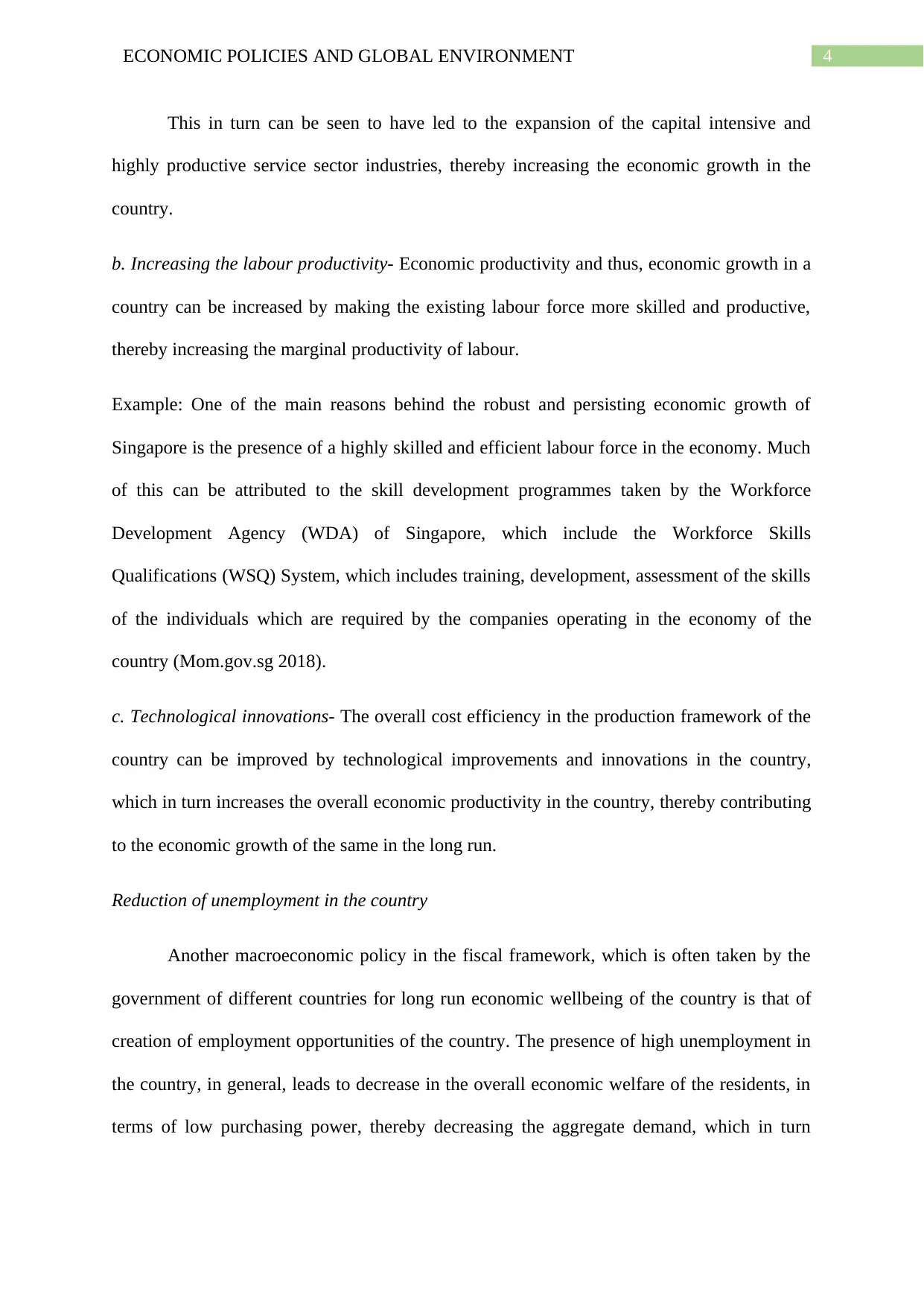
4ECONOMIC POLICIES AND GLOBAL ENVIRONMENT
This in turn can be seen to have led to the expansion of the capital intensive and
highly productive service sector industries, thereby increasing the economic growth in the
country.
b. Increasing the labour productivity- Economic productivity and thus, economic growth in a
country can be increased by making the existing labour force more skilled and productive,
thereby increasing the marginal productivity of labour.
Example: One of the main reasons behind the robust and persisting economic growth of
Singapore is the presence of a highly skilled and efficient labour force in the economy. Much
of this can be attributed to the skill development programmes taken by the Workforce
Development Agency (WDA) of Singapore, which include the Workforce Skills
Qualifications (WSQ) System, which includes training, development, assessment of the skills
of the individuals which are required by the companies operating in the economy of the
country (Mom.gov.sg 2018).
c. Technological innovations- The overall cost efficiency in the production framework of the
country can be improved by technological improvements and innovations in the country,
which in turn increases the overall economic productivity in the country, thereby contributing
to the economic growth of the same in the long run.
Reduction of unemployment in the country
Another macroeconomic policy in the fiscal framework, which is often taken by the
government of different countries for long run economic wellbeing of the country is that of
creation of employment opportunities of the country. The presence of high unemployment in
the country, in general, leads to decrease in the overall economic welfare of the residents, in
terms of low purchasing power, thereby decreasing the aggregate demand, which in turn
This in turn can be seen to have led to the expansion of the capital intensive and
highly productive service sector industries, thereby increasing the economic growth in the
country.
b. Increasing the labour productivity- Economic productivity and thus, economic growth in a
country can be increased by making the existing labour force more skilled and productive,
thereby increasing the marginal productivity of labour.
Example: One of the main reasons behind the robust and persisting economic growth of
Singapore is the presence of a highly skilled and efficient labour force in the economy. Much
of this can be attributed to the skill development programmes taken by the Workforce
Development Agency (WDA) of Singapore, which include the Workforce Skills
Qualifications (WSQ) System, which includes training, development, assessment of the skills
of the individuals which are required by the companies operating in the economy of the
country (Mom.gov.sg 2018).
c. Technological innovations- The overall cost efficiency in the production framework of the
country can be improved by technological improvements and innovations in the country,
which in turn increases the overall economic productivity in the country, thereby contributing
to the economic growth of the same in the long run.
Reduction of unemployment in the country
Another macroeconomic policy in the fiscal framework, which is often taken by the
government of different countries for long run economic wellbeing of the country is that of
creation of employment opportunities of the country. The presence of high unemployment in
the country, in general, leads to decrease in the overall economic welfare of the residents, in
terms of low purchasing power, thereby decreasing the aggregate demand, which in turn
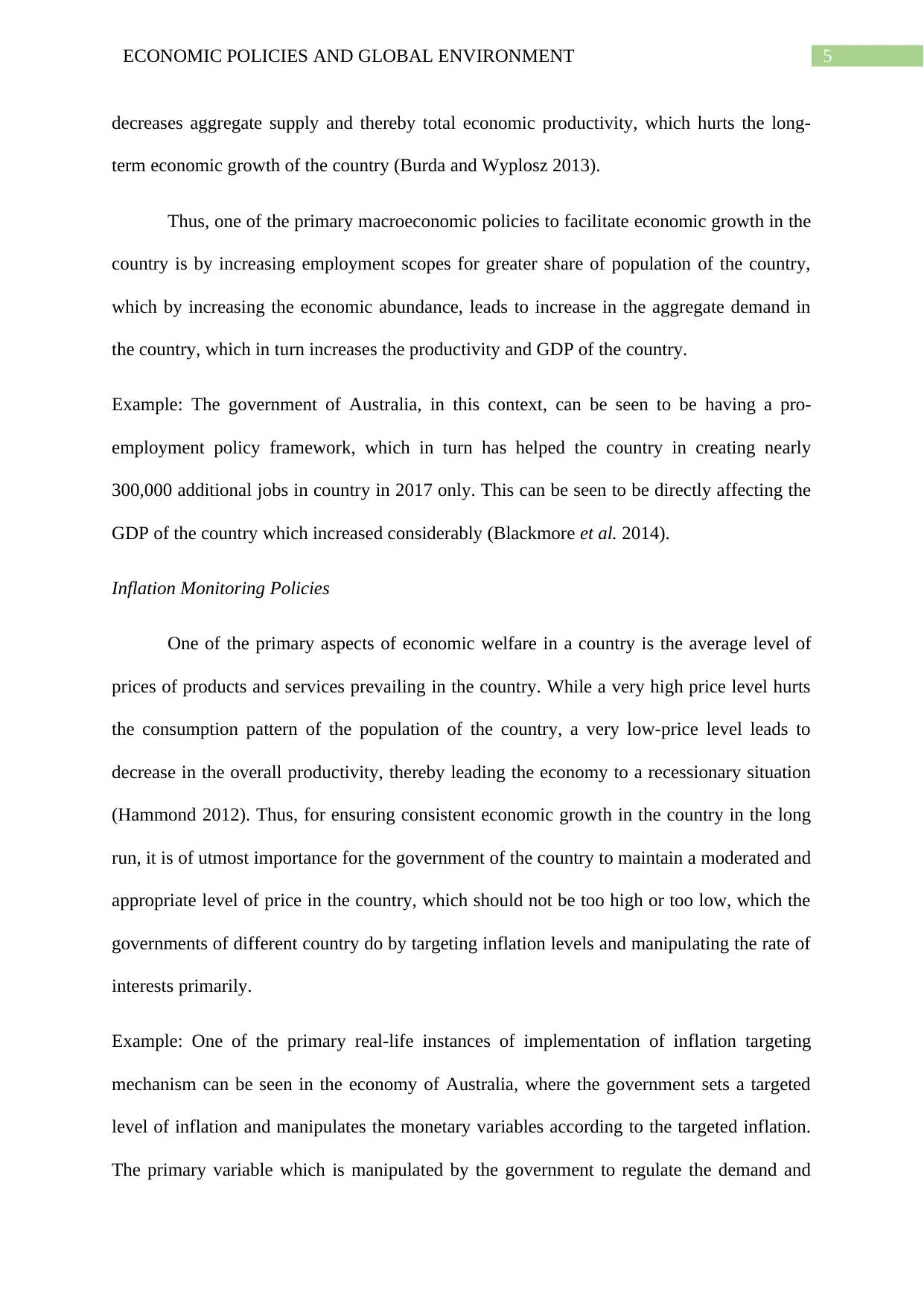
5ECONOMIC POLICIES AND GLOBAL ENVIRONMENT
decreases aggregate supply and thereby total economic productivity, which hurts the long-
term economic growth of the country (Burda and Wyplosz 2013).
Thus, one of the primary macroeconomic policies to facilitate economic growth in the
country is by increasing employment scopes for greater share of population of the country,
which by increasing the economic abundance, leads to increase in the aggregate demand in
the country, which in turn increases the productivity and GDP of the country.
Example: The government of Australia, in this context, can be seen to be having a pro-
employment policy framework, which in turn has helped the country in creating nearly
300,000 additional jobs in country in 2017 only. This can be seen to be directly affecting the
GDP of the country which increased considerably (Blackmore et al. 2014).
Inflation Monitoring Policies
One of the primary aspects of economic welfare in a country is the average level of
prices of products and services prevailing in the country. While a very high price level hurts
the consumption pattern of the population of the country, a very low-price level leads to
decrease in the overall productivity, thereby leading the economy to a recessionary situation
(Hammond 2012). Thus, for ensuring consistent economic growth in the country in the long
run, it is of utmost importance for the government of the country to maintain a moderated and
appropriate level of price in the country, which should not be too high or too low, which the
governments of different country do by targeting inflation levels and manipulating the rate of
interests primarily.
Example: One of the primary real-life instances of implementation of inflation targeting
mechanism can be seen in the economy of Australia, where the government sets a targeted
level of inflation and manipulates the monetary variables according to the targeted inflation.
The primary variable which is manipulated by the government to regulate the demand and
decreases aggregate supply and thereby total economic productivity, which hurts the long-
term economic growth of the country (Burda and Wyplosz 2013).
Thus, one of the primary macroeconomic policies to facilitate economic growth in the
country is by increasing employment scopes for greater share of population of the country,
which by increasing the economic abundance, leads to increase in the aggregate demand in
the country, which in turn increases the productivity and GDP of the country.
Example: The government of Australia, in this context, can be seen to be having a pro-
employment policy framework, which in turn has helped the country in creating nearly
300,000 additional jobs in country in 2017 only. This can be seen to be directly affecting the
GDP of the country which increased considerably (Blackmore et al. 2014).
Inflation Monitoring Policies
One of the primary aspects of economic welfare in a country is the average level of
prices of products and services prevailing in the country. While a very high price level hurts
the consumption pattern of the population of the country, a very low-price level leads to
decrease in the overall productivity, thereby leading the economy to a recessionary situation
(Hammond 2012). Thus, for ensuring consistent economic growth in the country in the long
run, it is of utmost importance for the government of the country to maintain a moderated and
appropriate level of price in the country, which should not be too high or too low, which the
governments of different country do by targeting inflation levels and manipulating the rate of
interests primarily.
Example: One of the primary real-life instances of implementation of inflation targeting
mechanism can be seen in the economy of Australia, where the government sets a targeted
level of inflation and manipulates the monetary variables according to the targeted inflation.
The primary variable which is manipulated by the government to regulate the demand and
⊘ This is a preview!⊘
Do you want full access?
Subscribe today to unlock all pages.

Trusted by 1+ million students worldwide
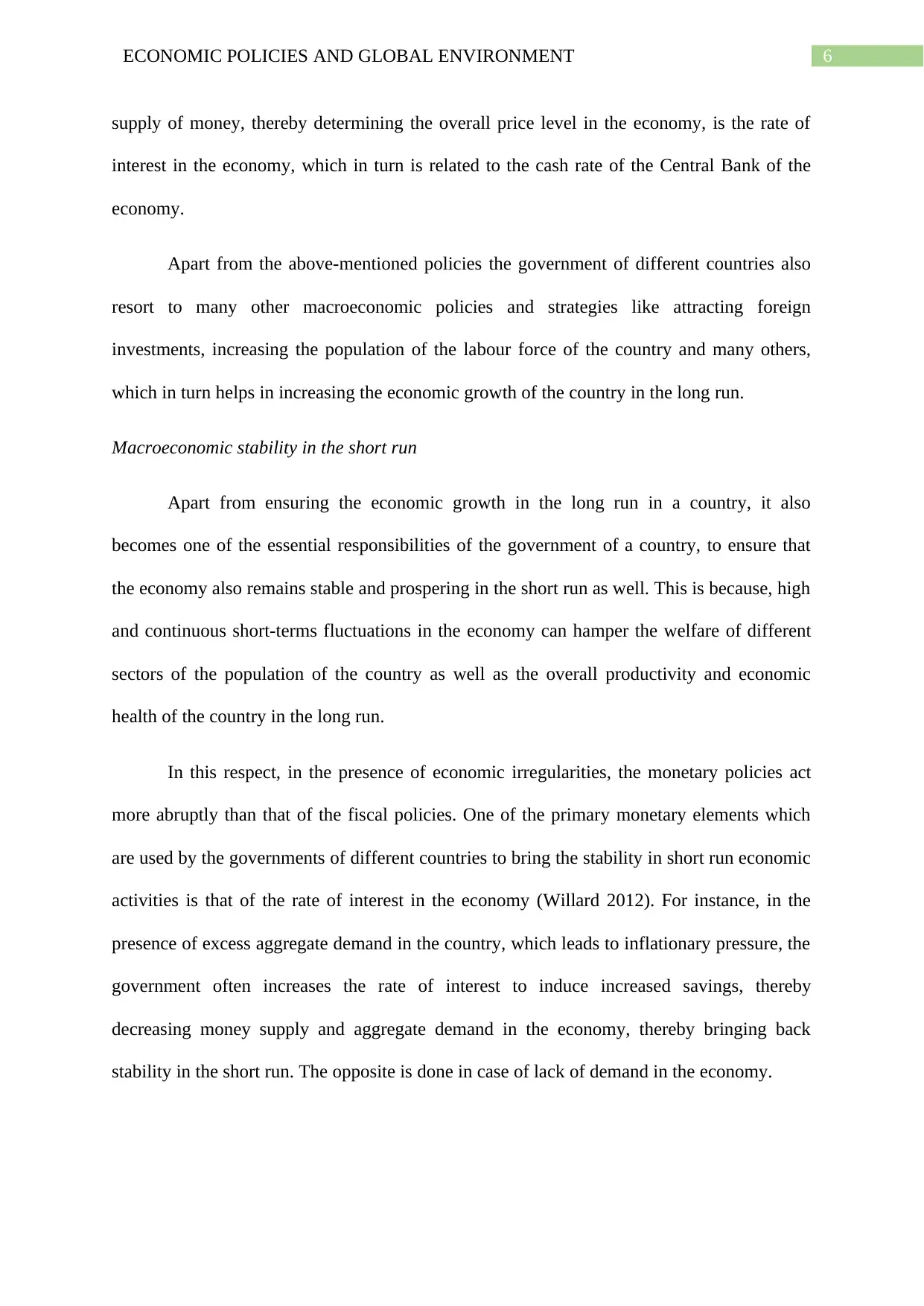
6ECONOMIC POLICIES AND GLOBAL ENVIRONMENT
supply of money, thereby determining the overall price level in the economy, is the rate of
interest in the economy, which in turn is related to the cash rate of the Central Bank of the
economy.
Apart from the above-mentioned policies the government of different countries also
resort to many other macroeconomic policies and strategies like attracting foreign
investments, increasing the population of the labour force of the country and many others,
which in turn helps in increasing the economic growth of the country in the long run.
Macroeconomic stability in the short run
Apart from ensuring the economic growth in the long run in a country, it also
becomes one of the essential responsibilities of the government of a country, to ensure that
the economy also remains stable and prospering in the short run as well. This is because, high
and continuous short-terms fluctuations in the economy can hamper the welfare of different
sectors of the population of the country as well as the overall productivity and economic
health of the country in the long run.
In this respect, in the presence of economic irregularities, the monetary policies act
more abruptly than that of the fiscal policies. One of the primary monetary elements which
are used by the governments of different countries to bring the stability in short run economic
activities is that of the rate of interest in the economy (Willard 2012). For instance, in the
presence of excess aggregate demand in the country, which leads to inflationary pressure, the
government often increases the rate of interest to induce increased savings, thereby
decreasing money supply and aggregate demand in the economy, thereby bringing back
stability in the short run. The opposite is done in case of lack of demand in the economy.
supply of money, thereby determining the overall price level in the economy, is the rate of
interest in the economy, which in turn is related to the cash rate of the Central Bank of the
economy.
Apart from the above-mentioned policies the government of different countries also
resort to many other macroeconomic policies and strategies like attracting foreign
investments, increasing the population of the labour force of the country and many others,
which in turn helps in increasing the economic growth of the country in the long run.
Macroeconomic stability in the short run
Apart from ensuring the economic growth in the long run in a country, it also
becomes one of the essential responsibilities of the government of a country, to ensure that
the economy also remains stable and prospering in the short run as well. This is because, high
and continuous short-terms fluctuations in the economy can hamper the welfare of different
sectors of the population of the country as well as the overall productivity and economic
health of the country in the long run.
In this respect, in the presence of economic irregularities, the monetary policies act
more abruptly than that of the fiscal policies. One of the primary monetary elements which
are used by the governments of different countries to bring the stability in short run economic
activities is that of the rate of interest in the economy (Willard 2012). For instance, in the
presence of excess aggregate demand in the country, which leads to inflationary pressure, the
government often increases the rate of interest to induce increased savings, thereby
decreasing money supply and aggregate demand in the economy, thereby bringing back
stability in the short run. The opposite is done in case of lack of demand in the economy.
Paraphrase This Document
Need a fresh take? Get an instant paraphrase of this document with our AI Paraphraser
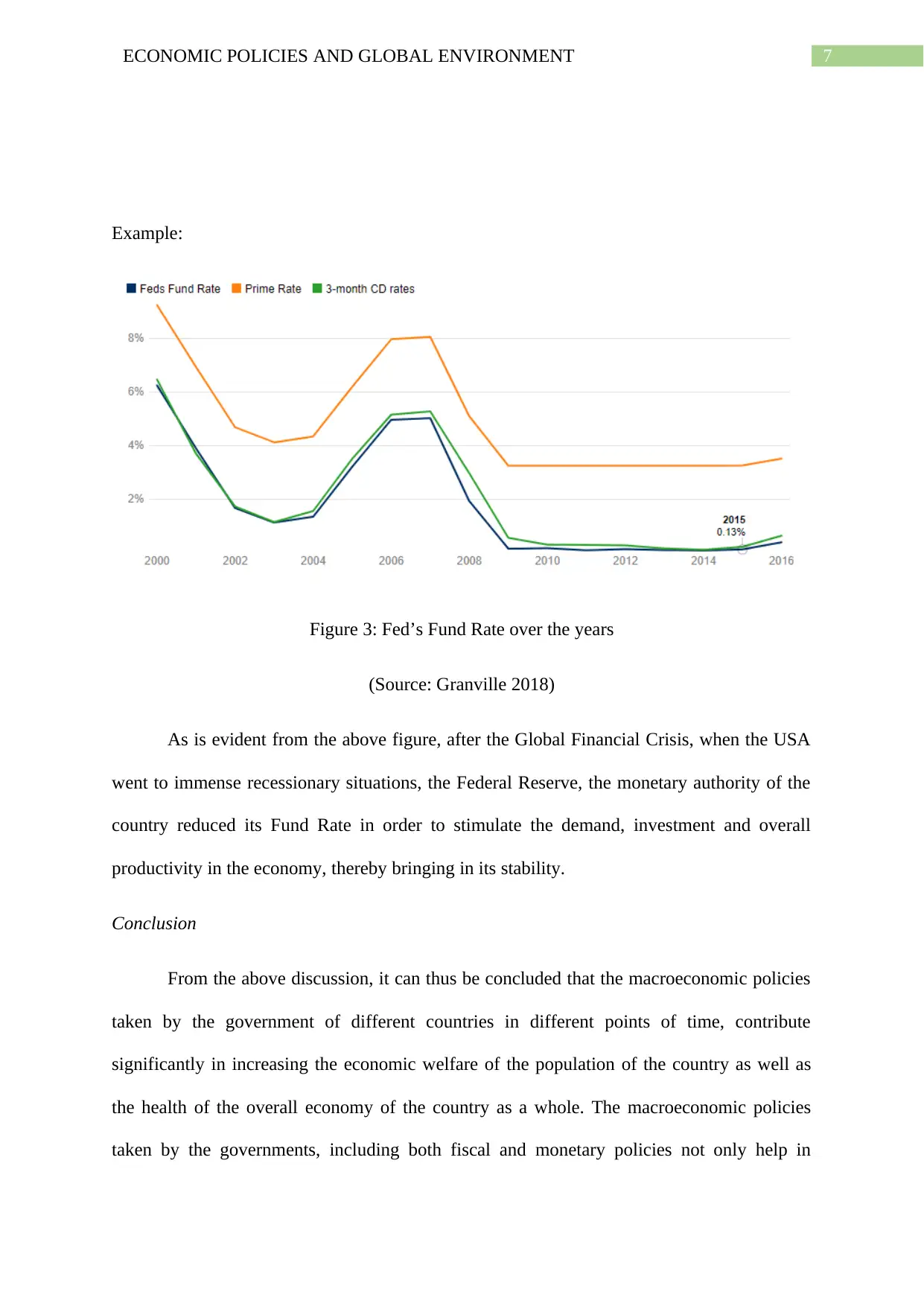
7ECONOMIC POLICIES AND GLOBAL ENVIRONMENT
Example:
Figure 3: Fed’s Fund Rate over the years
(Source: Granville 2018)
As is evident from the above figure, after the Global Financial Crisis, when the USA
went to immense recessionary situations, the Federal Reserve, the monetary authority of the
country reduced its Fund Rate in order to stimulate the demand, investment and overall
productivity in the economy, thereby bringing in its stability.
Conclusion
From the above discussion, it can thus be concluded that the macroeconomic policies
taken by the government of different countries in different points of time, contribute
significantly in increasing the economic welfare of the population of the country as well as
the health of the overall economy of the country as a whole. The macroeconomic policies
taken by the governments, including both fiscal and monetary policies not only help in
Example:
Figure 3: Fed’s Fund Rate over the years
(Source: Granville 2018)
As is evident from the above figure, after the Global Financial Crisis, when the USA
went to immense recessionary situations, the Federal Reserve, the monetary authority of the
country reduced its Fund Rate in order to stimulate the demand, investment and overall
productivity in the economy, thereby bringing in its stability.
Conclusion
From the above discussion, it can thus be concluded that the macroeconomic policies
taken by the government of different countries in different points of time, contribute
significantly in increasing the economic welfare of the population of the country as well as
the health of the overall economy of the country as a whole. The macroeconomic policies
taken by the governments, including both fiscal and monetary policies not only help in
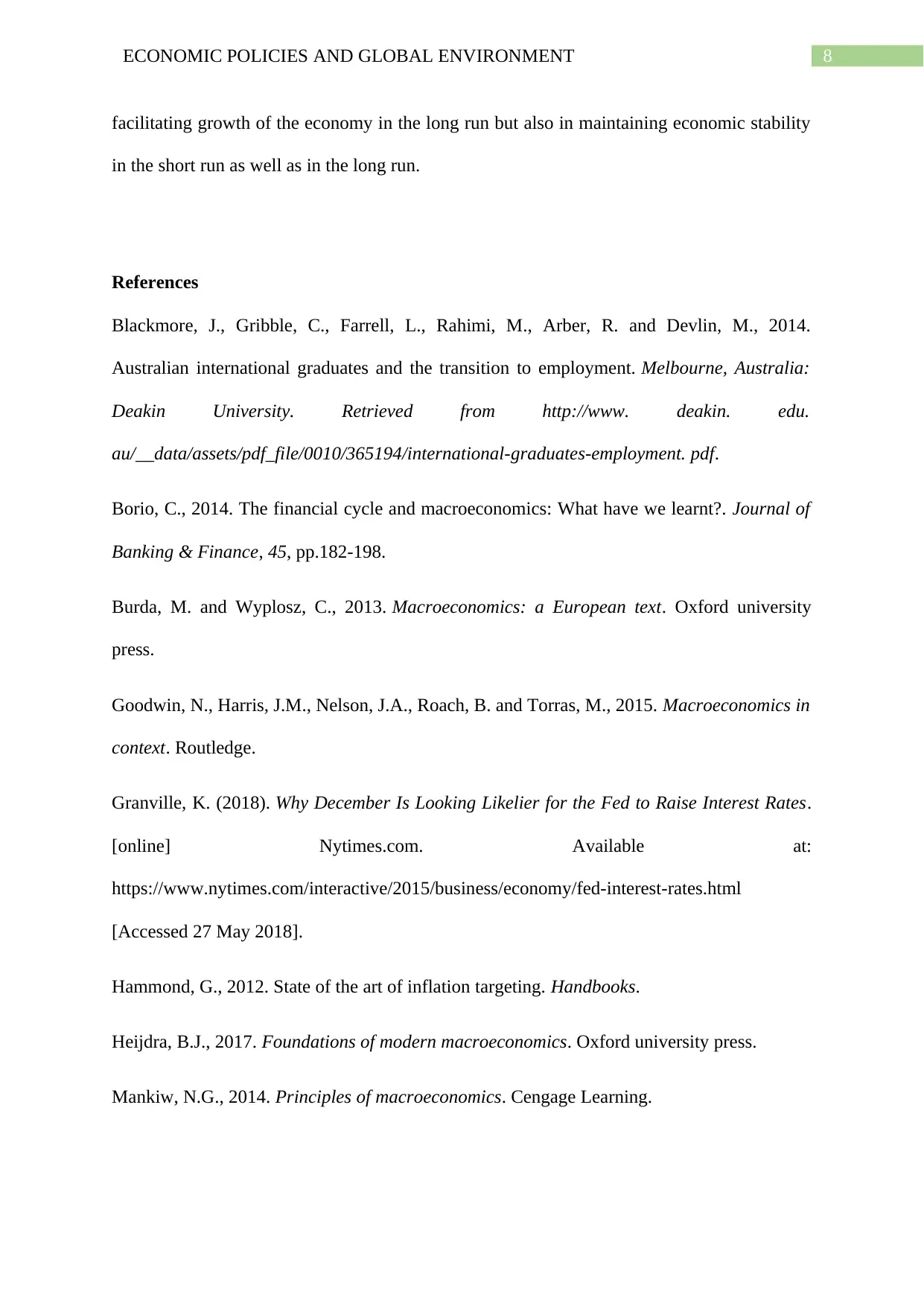
8ECONOMIC POLICIES AND GLOBAL ENVIRONMENT
facilitating growth of the economy in the long run but also in maintaining economic stability
in the short run as well as in the long run.
References
Blackmore, J., Gribble, C., Farrell, L., Rahimi, M., Arber, R. and Devlin, M., 2014.
Australian international graduates and the transition to employment. Melbourne, Australia:
Deakin University. Retrieved from http://www. deakin. edu.
au/__data/assets/pdf_file/0010/365194/international-graduates-employment. pdf.
Borio, C., 2014. The financial cycle and macroeconomics: What have we learnt?. Journal of
Banking & Finance, 45, pp.182-198.
Burda, M. and Wyplosz, C., 2013. Macroeconomics: a European text. Oxford university
press.
Goodwin, N., Harris, J.M., Nelson, J.A., Roach, B. and Torras, M., 2015. Macroeconomics in
context. Routledge.
Granville, K. (2018). Why December Is Looking Likelier for the Fed to Raise Interest Rates.
[online] Nytimes.com. Available at:
https://www.nytimes.com/interactive/2015/business/economy/fed-interest-rates.html
[Accessed 27 May 2018].
Hammond, G., 2012. State of the art of inflation targeting. Handbooks.
Heijdra, B.J., 2017. Foundations of modern macroeconomics. Oxford university press.
Mankiw, N.G., 2014. Principles of macroeconomics. Cengage Learning.
facilitating growth of the economy in the long run but also in maintaining economic stability
in the short run as well as in the long run.
References
Blackmore, J., Gribble, C., Farrell, L., Rahimi, M., Arber, R. and Devlin, M., 2014.
Australian international graduates and the transition to employment. Melbourne, Australia:
Deakin University. Retrieved from http://www. deakin. edu.
au/__data/assets/pdf_file/0010/365194/international-graduates-employment. pdf.
Borio, C., 2014. The financial cycle and macroeconomics: What have we learnt?. Journal of
Banking & Finance, 45, pp.182-198.
Burda, M. and Wyplosz, C., 2013. Macroeconomics: a European text. Oxford university
press.
Goodwin, N., Harris, J.M., Nelson, J.A., Roach, B. and Torras, M., 2015. Macroeconomics in
context. Routledge.
Granville, K. (2018). Why December Is Looking Likelier for the Fed to Raise Interest Rates.
[online] Nytimes.com. Available at:
https://www.nytimes.com/interactive/2015/business/economy/fed-interest-rates.html
[Accessed 27 May 2018].
Hammond, G., 2012. State of the art of inflation targeting. Handbooks.
Heijdra, B.J., 2017. Foundations of modern macroeconomics. Oxford university press.
Mankiw, N.G., 2014. Principles of macroeconomics. Cengage Learning.
⊘ This is a preview!⊘
Do you want full access?
Subscribe today to unlock all pages.

Trusted by 1+ million students worldwide
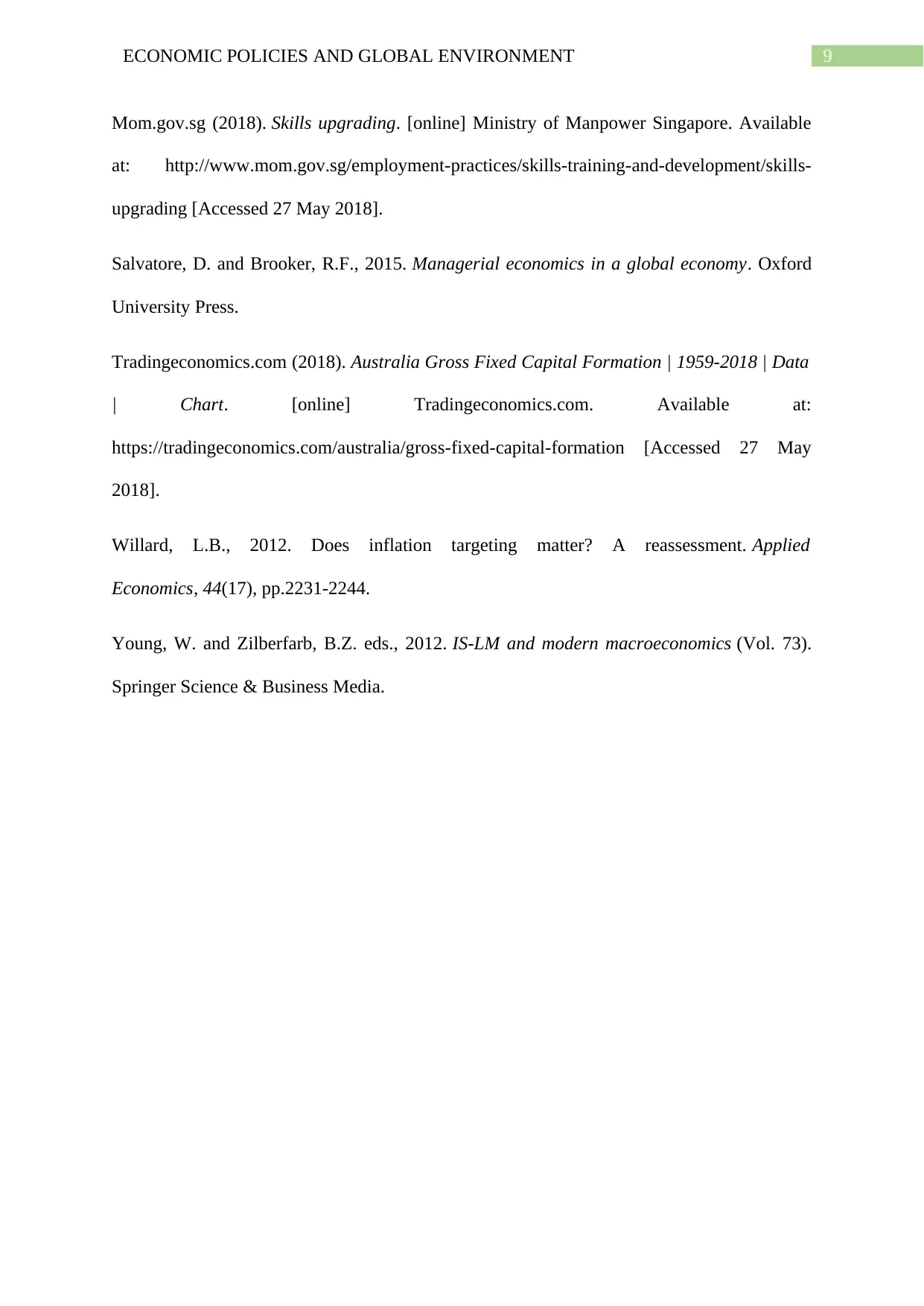
9ECONOMIC POLICIES AND GLOBAL ENVIRONMENT
Mom.gov.sg (2018). Skills upgrading. [online] Ministry of Manpower Singapore. Available
at: http://www.mom.gov.sg/employment-practices/skills-training-and-development/skills-
upgrading [Accessed 27 May 2018].
Salvatore, D. and Brooker, R.F., 2015. Managerial economics in a global economy. Oxford
University Press.
Tradingeconomics.com (2018). Australia Gross Fixed Capital Formation | 1959-2018 | Data
| Chart. [online] Tradingeconomics.com. Available at:
https://tradingeconomics.com/australia/gross-fixed-capital-formation [Accessed 27 May
2018].
Willard, L.B., 2012. Does inflation targeting matter? A reassessment. Applied
Economics, 44(17), pp.2231-2244.
Young, W. and Zilberfarb, B.Z. eds., 2012. IS-LM and modern macroeconomics (Vol. 73).
Springer Science & Business Media.
Mom.gov.sg (2018). Skills upgrading. [online] Ministry of Manpower Singapore. Available
at: http://www.mom.gov.sg/employment-practices/skills-training-and-development/skills-
upgrading [Accessed 27 May 2018].
Salvatore, D. and Brooker, R.F., 2015. Managerial economics in a global economy. Oxford
University Press.
Tradingeconomics.com (2018). Australia Gross Fixed Capital Formation | 1959-2018 | Data
| Chart. [online] Tradingeconomics.com. Available at:
https://tradingeconomics.com/australia/gross-fixed-capital-formation [Accessed 27 May
2018].
Willard, L.B., 2012. Does inflation targeting matter? A reassessment. Applied
Economics, 44(17), pp.2231-2244.
Young, W. and Zilberfarb, B.Z. eds., 2012. IS-LM and modern macroeconomics (Vol. 73).
Springer Science & Business Media.
1 out of 10
Related Documents
Your All-in-One AI-Powered Toolkit for Academic Success.
+13062052269
info@desklib.com
Available 24*7 on WhatsApp / Email
![[object Object]](/_next/static/media/star-bottom.7253800d.svg)
Unlock your academic potential
Copyright © 2020–2025 A2Z Services. All Rights Reserved. Developed and managed by ZUCOL.


